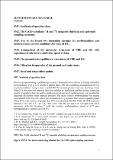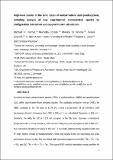Files in this item
High-level studies of the ionic states of norbornadiene and quadricyclane, including analysis of new experimental photoelectron spectra by configuration interaction and coupled cluster calculations
Item metadata
| dc.contributor.author | Palmer, Michael H | |
| dc.contributor.author | Coreno, Marcello | |
| dc.contributor.author | de Simone, Monica | |
| dc.contributor.author | Grazioli, Cesare | |
| dc.contributor.author | Aitken, R Alan | |
| dc.contributor.author | Hoffmann, Søren V | |
| dc.contributor.author | Jones, Nykola C | |
| dc.contributor.author | Peureux, Coralyse | |
| dc.date.accessioned | 2020-12-07T15:58:14Z | |
| dc.date.available | 2020-12-07T15:58:14Z | |
| dc.date.issued | 2020-11-30 | |
| dc.identifier | 271085498 | |
| dc.identifier | 66675588-2ab6-41d7-939b-5e663eff35e9 | |
| dc.identifier | 85097036973 | |
| dc.identifier | 000596592200002 | |
| dc.identifier.citation | Palmer , M H , Coreno , M , de Simone , M , Grazioli , C , Aitken , R A , Hoffmann , S V , Jones , N C & Peureux , C 2020 , ' High-level studies of the ionic states of norbornadiene and quadricyclane, including analysis of new experimental photoelectron spectra by configuration interaction and coupled cluster calculations ' , The Journal of Chemical Physics , vol. 153 , no. 20 , 204303 . https://doi.org/10.1063/5.0031387 | en |
| dc.identifier.issn | 0021-9606 | |
| dc.identifier.other | ORCID: /0000-0001-6959-5311/work/84753132 | |
| dc.identifier.uri | https://hdl.handle.net/10023/21094 | |
| dc.description.abstract | Synchrotron-based photoelectron spectra (PES) of norbornadiene (NBD) and quadricyclane (QC) differ significantly from those in previous studies. The adiabatic ionization energy (AIE1) for NBD, assigned to the 2B1 state at 8.279 eV, shows a progression of 18 members with decreasing vibration frequency from 390 cm−1 to 340 cm−1; our calculated frequency is 381 cm−1. Similarly, the AIE1 for QC at 7.671 eV, assigned to the 2B2 state, discloses a vibrational progression of nine or more members with vibration frequency decreasing from 703 cm−1 to 660 cm−1; our calculated vibration frequency is 663 cm−1. These AIEs, determined by coupled cluster and fourth order Møller–Plesset perturbation theory, were very similar to the corresponding second order perturbation theory results. The calculated AIE symmetry sequences are 2B1 < 2A1 < 2A2 < 2B2 for NBD and 2B2 < 2A2 < 2B1 < 2A1 for QC. The overall PES vertical ionization energy profiles for both compounds were closely reproduced by Tamm–Dancoff approximation energies and intensities. The vibrational structure of the ionic states, determined using Franck–Condon methods, gave a good account of the observed spectra, but the observed envelopes for both IE1 are complex sets of vibrations, rather than single progressions. The NMR spectra for QC showed residual second order properties at 300 MHz; both QC and NBD have been theoretically analyzed in greater detail using AA/BB/CC/XX/ spectra, where all H are coupled; the magnetic shielding and spin–spin coupling constants obtained are similar to experimental values. | |
| dc.format.extent | 16 | |
| dc.format.extent | 3691796 | |
| dc.format.extent | 1163471 | |
| dc.language.iso | eng | |
| dc.relation.ispartof | The Journal of Chemical Physics | en |
| dc.subject | QD Chemistry | en |
| dc.subject | NDAS | en |
| dc.subject.lcc | QD | en |
| dc.title | High-level studies of the ionic states of norbornadiene and quadricyclane, including analysis of new experimental photoelectron spectra by configuration interaction and coupled cluster calculations | en |
| dc.type | Journal article | en |
| dc.contributor.institution | University of St Andrews. School of Chemistry | en |
| dc.contributor.institution | University of St Andrews. EaSTCHEM | en |
| dc.identifier.doi | https://doi.org/10.1063/5.0031387 | |
| dc.description.status | Peer reviewed | en |
This item appears in the following Collection(s)
Items in the St Andrews Research Repository are protected by copyright, with all rights reserved, unless otherwise indicated.


